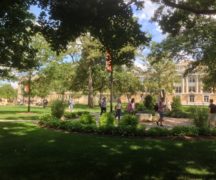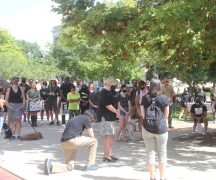From BGSU OFFICE OF MARKETING & COMMUNICATIONS
BGSU is among the nation’s most environmentally responsible colleges, according to the 2016 Princeton Review Guide to 361 Green Colleges.
The review chose the colleges for the seventh annual edition based on data from the company’s 2015-16 survey of hundreds of four-year colleges concerning their commitment to the environment and sustainability. BGSU scored 90 on the 100-point scale. Except for the top 50 schools, colleges are not ranked in any order.
The ranking provides a good reference for prospective students. Environmentally conscious, college-bound students increasingly seek schools compatible with their beliefs, said Robert Franek, Princeton Review’s senior vice president and publisher.
“I’m so very proud that our sustainability efforts have been recognized by the Princeton Review guide,” said BGSU President Mary Ellen Mazey, who in 2012 signed the American College and University Presidents’ Climate Commitment, lending BGSU’s support to the effort to promote climate neutrality and sustainability. “Students, faculty and staff have all taken leadership roles in moving us toward our goals and making us a more environmentally aware and responsible institution.”
The profiles in the Green Colleges Guide include “Green Facts” about the schools with details on such things as the availability of transportation alternatives and whether the school employs a sustainability officer. They also provide information about each school’s admission requirements, cost and financial aid and student body statistics.
To be included in the guide, schools must submit an exhaustive report. “It’s quite detailed in so many areas,” said Dr. Nicholas Hennessy, campus sustainability manager, adding that it goes far beyond most people’s basic concept of recycling as a sustainability marker.
People might be surprised to know that, in addition to the obvious criteria like sustainable practices in the operations area, the green guide also places a strong emphasis on academics, Hennessy said.
“They look at the courses offered and ask ‘What are you teaching your students about the environment and sustainability?’ What opportunities are available to them outside of class?’ They also look at who on the faculty is doing sustainability research. The idea is that, as a higher education institution, we have the talent, the opportunity and the resources to educate more civically engaged citizens.”
Hennessy pointed out BGSU’s alternative break programs as good examples of extracurricular activities that can have an environmental focus. Students have worked in watershed areas and alternative energy projects in North Carolina, for example. Other big events on campus, such as the annual Martin Luther King Day of Service conducted by the Center for Community and Civic Engagement, use sustainable practices, he added. And, along with tangible projects, a major goal of the student-led Student Green Initiative Fund is raising consciousness.
“So much of making progress is about changing attitudes and changing behaviors,” said Steven Krakoff, vice president for capital planning and campus operations. “Sustainability has to become ingrained in the way we function and raise awareness on campus.”
Hennessy compiled BGSU’s report for Princeton, including such things as institutional policies, purchasing practices and operational areas such as how much renewable energy the university uses and the school’s carbon footprint, he said.
Even campus dining services are included in the audit. For example, BGSU gets points for the percentage of the food budget spent on local or organic food (78 percent) and its pre-consumer composting in the dining halls.
Having Chartwells as the University’s food provider has been a major boon in that area, Krakoff said. “They are all about sustainability as a corporate policy,” he said. “There’s been a big push from them and greater visibility for the concept.”
BGSU also gained points for its waste-diversion practices, Hennessy said, which include recycling, re-using and donating goods. The annual semester-end “When You Move Out, Don’t Throw It Out” collection of mainly student items nets an enormous amount of clothing, household goods and even food that goes to those in need — and not into the landfills. In addition to helping others, it reduces the cost BGSU must pay for landfill use.
The University’s hybrid recycling truck is a model in the state, and is very visible at home football games where “Green Game Days” encourage recycling but also use of non-disposable items. The Student Green Initiative Fund helped with the purchase of the truck, along with many other campus environmental advances.
In terms of bricks and mortar, the University now has a policy that all significant construction or renovation projects must attain at least silver certification in LEED (Leadership in Energy and Environmental Design), Krakoff said. This has become easier today, now that it is common practice for engineering and architecture firms to automatically incorporate sustainable practices in their projects as a matter of social responsibility, he said.
BGSU has made important sustainability strides in its capital projects as well as in energy conservation, enabling it to be both fiscally and environmentally responsible, Krakoff said. “These policies are all aligned and support compatible objectives.”
“One of the most important ingredients to a successful sustainability program on a college campus is the ability to collaborate with many different and diverse groups,” said Bruce Meyer, assistant vice president for campus operations. “Nick is absolutely fabulous at working with these groups. He is also very active in the city of Bowling Green, surrounding communities and the state of Ohio.”
Thanks to the efforts of concerned BGSU community members and support from leadership, progress in those areas has gained momentum over the last several years, Krakoff said. With President Mazey’s signing of the Climate Commitment and the action plan it entailed, the University has a framework for working toward its goals.
“Being named to the Princeton Review Guide to Green Colleges is not something you achieve and then you remain static,” Hennessy said. “It’s a continuous process and we need to keep moving. The bar keeps rising as the stakes get higher. Every year we learn about what we don’t have, so this is an opportunity to learn.
“It’s also a reflection of what many areas across campus are doing or not doing. It’s a collaborative effort: We’re all a part of the team. We’re only as good as what we do as an institution.”





